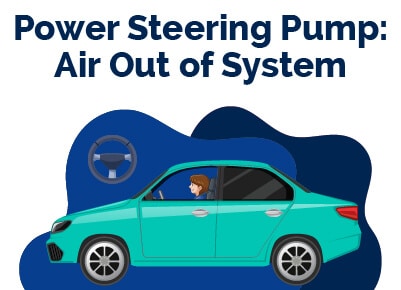Why Power Steering Pump Will Not Bleed Air Out of System
May 7, 2023


I am a serial entrepreneur and a consumer advocate. When I’m not helping car buyers, I love working on ventures that have a positive impact.
I run a cause marketing agency and serve on the board of Vayu Global Health where we are disrupting the medical industry and preventing the needless deaths of mothers and babies during childbirth.
It's often confusing when the power steering pump won't bleed out air. There are reasons for this anomaly, and we'll identify some of them today.
If you hear whining and groaning noises from your car, it's probably a sign that your power steering system has gotten air into it.
But unfortunately, the air in the power steering makes the entire driving experience unpleasant.
Table of Contents
Power Steering Won't Bleed Out Air Video
What Is a Steering Pump?
A power steering pump is a component that helps control the pressure applied to your car's wheels. It can also smoothly turn in different directions.
The power steering pump's pressure comes from the tank's power steering fluid. It then passes through the steering box.
A supplement drive belt can also turn the power steering hose and push the air pressure inside the control valve.
The power steering pump ensures that the fluid you're instigating reaches the power steering system of your vehicle.
It has a rotating rotor that allows fluid to quickly enter the car's rotor.
What Causes Air in Power Steering?
The prevalent way air can enter the power steering system is through the hose connected to the pump. If there's a bad connection, the air will enter the system.
If the air build-up in the power steering fluid gets too high, it can cause a spongy feeling in the steering system.
Other problems can also occur due to the build-up of air in the reservoir.
Why Power Steering Pump Will Not Bleed Air Out of System
Hydraulic pressure is a component utilized in the power steering system. Hydraulic pressure helps make the driving experience more pleasant.
It can also help you steer your car to the right and left directions. It additionally prevents it from going in the wrong direction.
If air has gotten into your power steering pump, it will become noisy and laborious, and it will sound like the car is distressed.
A more direct sign is that the pump will start to sound loud.
Getting rid of the air from the system can be challenging, but it's also possible. There are various ways to remove the air from the power steering system.
The primary reason why the power steering pump will not bleed is if you're doing it wrongly.
How to Get Rid of Air in Power Steering
To successfully get rid of air in the power steering, take the following steps:
- Follow the instructions in the manual to locate the power steering reservoir. This tank is usually found near the cooling system of the engine.
- After checking the power steering reservoir, fill it to the cold fill line. The type of fluid you need can be determined by reading the owner's manual.
- Before you start bleeding the power steering, close the cap. Doing this will prevent the fluid from leaking. Again, letting the air get out of the power steering system is essential.
- If the power steering has a bleed valve, you can use a vacuum pump kit to remove the air from the system.
After reading the owner's manual, follow the directions to slide the end of the vacuum pump's hose over the valve. If the gauge reads 20 Hg, then the air will be removed.
If you plan on using a vacuum pump to get rid of the air from the steering system, you might want to use an adapter for the reservoir lid. Various vacuum kits slide into the reservoir.
You can still remove the air from the steering system using a bleed valve.
Doing so is more straightforward than lifting the vehicle, which only takes around five minutes.
This method works if you have a bleed valve and don't have to elevate the car.
- Before lifting the vehicle off the ground, slide a choke or wedge behind the rear tires to stop it from sliding back.
After that, you can slide a hydraulic floor jack under the vehicle. Ensure the car is on a flat surface.
You can raise the vehicle's side by stepping on the jack's pedal several times. After that, slide a jack stand underneath it to support the wheels.
- Before starting the process, ensure your key is in the ignition.
Turning the key to start the vehicle will not allow you to remove the steering wheel. The key must be in the ignition to unlock the steering.
- One of the easiest ways to remove the air from the power steering system is by turning the wheel repeatedly.
This forces the air out of the system. It's essential to ensure that the wheels are rotated as long as possible to get the air out of the components and lines.
Open the cap and observe the level of the power steering fluid.
After you've looked at the power steering fluid level, add some more fluid if the level is low.
Add more to the reservoir to reach the cold fill line, ensuring the transmission fluid flows smoothly.
- After closing the power steering cap, go back inside the vehicle. Turn the wheel to lock again and allow the fluid to circulate through the lines.
This procedure should be repeated several times to allow the fluid to circulate.
If you're a regular car owner, this method should be repeated 20 times to allow the fluid to circulate.
On the other hand, if you're an SUV or minivan owner, follow this procedure 35 times.
- After turning off the engine, go back to the power steering reservoir and check its condition.
If the fluid is still bubbling at the top of the reservoir, then the air is still in the lines.
If the fluid is no longer bubbling, then the system is no longer affected by the air.
- Repeat the entire process if there's still bubbling till they disappear.
Best Car Deals by Category
Frequently Asked Questions
What happens if there is air in the power steering?
The power steering pump operates with hydraulics, so air entering the system can adversely affect it. When the air gets into the power-steering system, it will be compressed by the pump, leading to noise and difficulty in steering.
Can you bleed power steering with engine running?
Yes, you can bleed the power steering with your engine running, and it’s recommended to do so! This will make it effortless for you to turn the steering wheel from left to right, making several complete cycles to eliminate the air in the steering system.
Do you bleed power steering with cap on or off?
Yes, it’s recommended to leave the reservoir cap on while bleeding power steering to prevent fluid from burping into the engine compartment.
How long does it take to bleed a power steering pump?
On average, it takes about 20 to 50 minutes to bleed a power steering pump. But the time it will take you will depend on whether the steering pump, the steering gear, or rack and pinion will need replacing.
Posted in Car Buying Tips, Car Troubleshooting |




